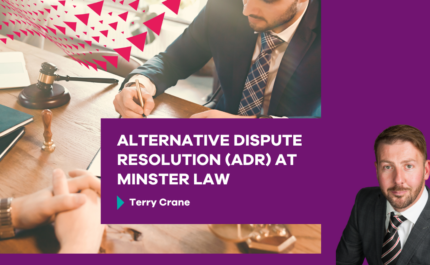
Marcus Taylor, Claims Director at Minster Law talks about the intent and results that sit behind their ground-breaking Alternative Dispute Resolution pilot program.
It’s not that often you can attribute the word ‘icon’ to a member of the legal profession, but in the case of the recently deceased US Supreme Court Judge Ruth Bader Ginsburg, it’s a befitting moniker to a visionary and pioneer in human rights and equality in all of their forms.
‘The Notorious R.B.G’ as she was known, has left an indelible mark on the US legal system and she represents a powerful example of someone who lived by their beliefs and wasn’t afraid to voice them. But I think she also understood that for ideas to take hold, you need to build consensus.
A little closer to home, no one could accuse either claimant law firms or insurers of being afraid to voice their beliefs. It’s been at the source of the adversarial relationship that has existed between our sectors for an age. Consensus, on the other hand, has continued to elude us.
We could learn a thing or two from R.B.G. She famously once said “Fight for the things that you care about, but do it in a way that will lead others to join you” – a perfect encapsulation of the intentions behind Minster’s ground-breaking ADR pilot.
As a claimant law firm, we’ve never subscribed to the notion that consensus can’t be achieved between the needs of both claimant and insurers. The reality is, we represent the needs of our clients and the vast majority of them don’t want a legal fight – they just want an appropriate and timely resolution. So, when it comes to how we best serve our clients, we promote consensus, rather than conflict.
It’s this approach that we have carried over into our ground-breaking Alternative Dispute Resolution (ADR) pilot program. The results speak to a far wider opportunity for customers, insurers, and claimant firms alike.
Through our pilot, we’re delivering settlement decisions on 100% of cases within an average of 10-days – a mere blink of the eye, compared to the 10+ months or so that a claimant can expect to wait for a Stage 3 court hearing. That’s significant and it shows how we can work together to find innovative ways to take cost and friction out of the claims process.
This has to be a welcome development for all parties – whether claimant, insurer, or law firm. And in the context of the courts, with 500,000 personal injury claims a year, an obvious opportunity to avoid contributing further to an already log-jammed legal system.
Earlier this month, we finally received the long-awaited confirmation on the implementation of whiplash reforms. Now firmly in the diary for May 2021 and with no ADR protocols in scope for delivery, the mantel falls to the progressives within our respective industries to find a solution, rather than waiting indefinitely for government intervention.
In this respect, the results of our ADR pilot have underscored the benefits of cooperation with insurers and they serve as a potential blueprint for driving delays and frictional costs out of the personal injury claims journey.
Our hope is that our pilot will serve as a catalyst for greater consensus and more widespread adoption of ADR in settling personal injury claims but in the words of the Notorious R.B.G. “Real change, enduring change, happens one step at a time.”
This is a momentum worth maintaining – the opportunity has been shown to be one too good to miss. In stepping past it, unlike Ginsberg we may miss our chance to also make an indelible mark on our own legal system.
– Marcus Taylor, Claims Director



